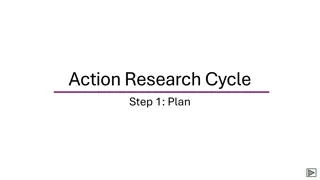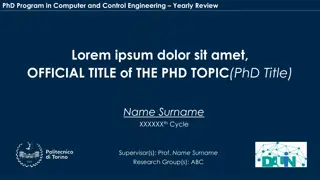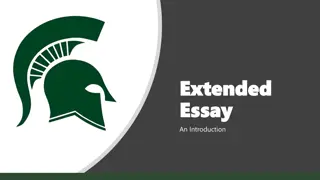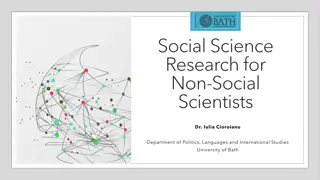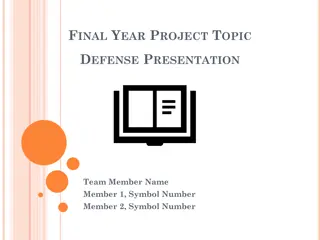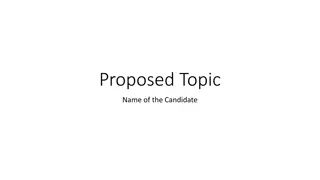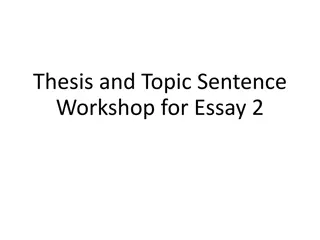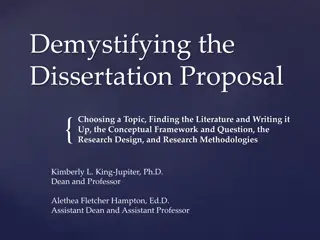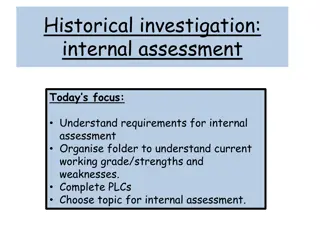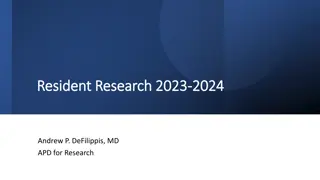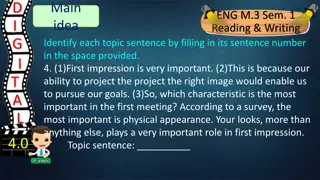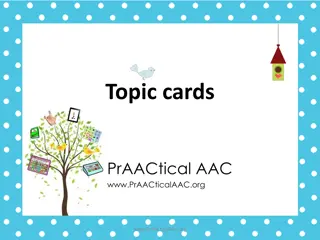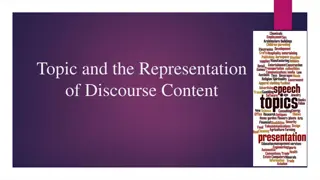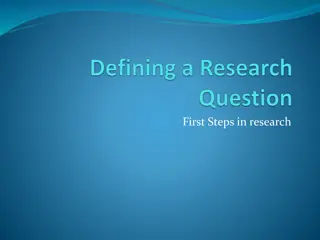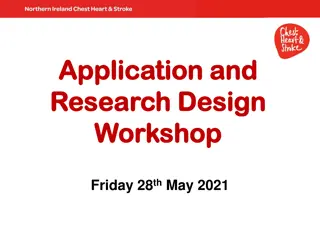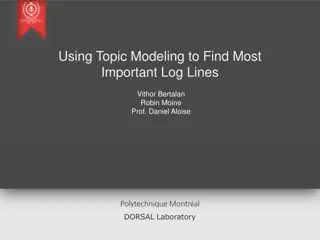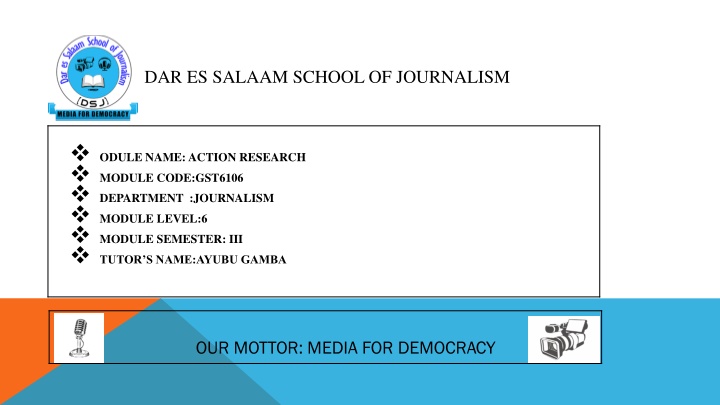
Research in Media Practice
Research in media practice involves a systematic inquiry process for collecting, analyzing, and interpreting data to address specific concerns or problems using scientific methods. Good research follows ethical practices and logical reasoning while ensuring accuracy in data collection and analysis. The purpose of research can be exploratory, descriptive, or explanatory, aiming to generate new knowledge and insights.
Download Presentation

Please find below an Image/Link to download the presentation.
The content on the website is provided AS IS for your information and personal use only. It may not be sold, licensed, or shared on other websites without obtaining consent from the author. If you encounter any issues during the download, it is possible that the publisher has removed the file from their server.
You are allowed to download the files provided on this website for personal or commercial use, subject to the condition that they are used lawfully. All files are the property of their respective owners.
The content on the website is provided AS IS for your information and personal use only. It may not be sold, licensed, or shared on other websites without obtaining consent from the author.
E N D
Presentation Transcript
DAR ES SALAAM SCHOOL OF JOURNALISM ODULE NAME: ACTION RESEARCH MODULE CODE:GST6106 DEPARTMENT :JOURNALISM MODULE LEVEL:6 MODULE SEMESTER: III TUTOR S NAME:AYUBU GAMBA OUR MOTTOR: MEDIA FOR DEMOCRACY
TOPIC 4 TOPIC 1 Use basic qualitative and quantitative Use basic qualitative and quantitative techniques in techniques in analyzing analyzing research finding Basic concepts of research in media Basic concepts of research in media practice practice research finding TOPIC 5 TOPIC 2 Apply research skills in preparing research Apply research skills in preparing research report report Knowledge of research design in media Knowledge of research design in media practices practices . TOPIC 3 Employ research skills in developing Employ research skills in developing research proposal research proposal
TOPIC 1:BASIC CONCEPTS OF RESEARCH IN MEDIA PRACTICE What is Research? Definition: Research is a process of systematic inquiry that entails collection of data; documentation of critical information; and analysis and interpretation of that data/information, in accordance with suitable methodologies set by specific professional fields and academic disciplines Research is defined as careful consideration of study regarding a particular concern or problem using scientific methods. According to the American sociologist Earl Robert Babbie, research is a systematic inquiry to describe, explain, predict, and control the observed phenomenon. It involves inductive and deductive methods. 3
WHAT ARE THE CHARACTERISTICS OF RESEARCH? Good research follows a systematic approach to capture accurate data. Researchers need to practice ethics and a code of conduct while making observations or drawing conclusions. The analysis is based on logical reasoning and involves both inductive and deductive methods. Real-time data and knowledge is derived from actual observations in natural settings. There is an in-depth analysis of all data collected so that there are no anomalies associated with it. It creates a path for generating new questions. Existing data helps create more research opportunities. It is analytical and uses all the available data so that there is no ambiguity in inference. Accuracy is one of the most critical aspects of research. The information must be accurate and correct. For example, laboratories provide a controlled environment to collect data. Accuracy is measured in the instruments used, the calibrations of instruments or tools, and the experiment s final result.
WHAT IS THE PURPOSE OF RESEARCH? WHAT IS THE PURPOSE OF RESEARCH? There are three main purposes: Exploratory: As the name suggests, researchers conduct exploratory studies to explore a group of questions. The answers and analytics may not offer a conclusion to the perceived problem. It is undertaken to handle new problem areas that haven t been explored before. This exploratory process lays the foundation for more conclusive data collection and analysis. Descriptive: It focuses on expanding knowledge on current issues through a process of data collection. Descriptive research describe the behavior of a sample population. Only one variable is required to conduct the study. The three primary purposes of descriptive studies are describing, explaining, and validating the findings. For example, a study conducted to know if top-level management leaders in the 21st century possess the moral right to receive a considerable sum of money from the company profit. Explanatory: Causal or explanatory research is conducted to understand the impact of specific changes in existing standard procedures. Running experiments is the most popular form. For example, a study that is conducted to understand the effect of rebranding on customer loyalty Research methods are broadly classified as Qualitative and Quantitative.
There are three main purposes: There are three main purposes: Exploratory: Exploratory: As the name suggests, researchers conduct As the name suggests, researchers conduct exploratory studies group of questions. The answers and analytics may not offer a conclusion to the group of questions. The answers and analytics may not offer a conclusion to the perceived problem. It is undertaken to handle new problem areas that haven t been perceived problem. It is undertaken to handle new problem areas that haven t been explored before. This exploratory process lays the foundation for more conclusive explored before. This exploratory process lays the foundation for more conclusive data collection and analysis. data collection and analysis. Descriptive: Descriptive: It It focuses on expanding knowledge on current issues through a process of focuses on expanding knowledge on current issues through a process of data collection. data collection. Descriptive research Descriptive research describe the behavior of a sample population. describe the behavior of a sample population. Only one variable is required to conduct the study. The three primary purposes of Only one variable is required to conduct the study. The three primary purposes of descriptive studies are describing, explaining, and validating the findings. For descriptive studies are describing, explaining, and validating the findings. For example, a study conducted to know if top example, a study conducted to know if top- -level management leaders in the 21st century possess the moral right to receive a considerable sum of money from the century possess the moral right to receive a considerable sum of money from the company profit. company profit. Explanatory: Explanatory: Causal or Causal or explanatory research explanatory research is conducted to understand the impact of specific changes in existing standard procedures. Running experiments is the most specific changes in existing standard procedures. Running experiments is the most popular form. For example, a study that is conducted to understand the effect of popular form. For example, a study that is conducted to understand the effect of rebranding on customer loyalty rebranding on customer loyalty Research methods are broadly classified as Research methods are broadly classified as Qualitative Qualitative and exploratory studies to explore a to explore a level management leaders in the 21st is conducted to understand the impact of and Quantitative. Quantitative.
CONTINUED Theoretical Research Theoretical research, also referred to as pure or basic research, focuses on generating knowledge, regardless of its practical application. Here, data collection is used to generate new general concepts for a better understanding of a particular field or to answer a theoretical research question. Results of this kind are usually oriented towards the formulation of theories and are usually based on documentary analysis, the development of mathematical formulas and the reflection of high-level researchers. For example, a philosophical dissertation, since the aim is to generate new approaches from existing data without considering how its findings can be applied or implemented in practice. Applied Research Here, the goal is to find strategies that can be used to address a specific research problem. Applied research draws on theory to generate practical scientific knowledge, and its use is very common in STEM fields such as engineering, computer science and medicine.
RESEARCH TITLE A research title prefaces the study by providing a summary of the main idea and is usually short and concise. Writing it may seem to be a simple task but it actually requires more consideration on the part of the researcher. While he or she may have written the contents of the study in great detail, researchers may find it hard to create a research title for their study that is concise and represents all the relevant elements of the study at the same time. A research title should have the following characteristics: 1. It should summarize the main idea of the paper. 2. It should be a concise statement of the main topic. 3. It should include the major variables of the research study. 4. It should be self-explanatory 5. It should describe or imply the participants of the study. In general, the researcher should avoid using words that serve no useful purpose and can mislead indexers Words such as "methods," "results," and "investigations" should not appear in the title. In many cases, the general problem of the research or even the specific question that the researcher intends to answer, when rewritten in a statement form, can serve as the title
HOW TO WRITE A RESEARCH PAPER TITLE IN 5 STEPS HOW TO WRITE A RESEARCH PAPER TITLE IN 5 STEPS You might wonder how you are supposed to pick a title from all the content that your manuscript contains how are you supposed to choose? What will make your research paper title come up in search engines and what will make the people in your field read it? In a nutshell, your research title should accurately capture what you have done, it should sound interesting to the people who work on the same or a similar topic, and it should contain the important title keywords that other researchers use when looking for literature in databases. To make the title writing process as simple as possible, we have broken it down into 5 simple steps. Step 1: Answer some key questions about your research paper What does your paper seek to answer and what does it accomplish? Try to answer these questions as briefly as possible. You can create these questions by going through each section of your paper and finding the MOST relevant information to make a research title
Research question One-sentence answer My paper studies how program volume affects outcomes for liver transplant patients on waiting lists. What is my paper about? What methods/techniques did I use to perform my study? It s a case study. I studied 60 cases of liver transplant patients on a waiting list throughout the US aged 20-50 years. What or who was the subject of my study? My study revealed a positive correlation between waitlist volume and negative prognosis of transplant procedure. What did I find?
STEP 2: IDENTIFY RESEARCH STUDY STEP 2: IDENTIFY RESEARCH STUDY KEYWORDS KEYWORDS Now that you have answers to your research questions, find the most important parts of these responses and Now that you have answers to your research questions, find the most important parts of these responses and make these your study keywords. Note that you should only choose the most important terms for your keywords make these your study keywords. Note that you should only choose the most important terms for your keywords journals usually request anywhere from 3 to 8 keywords maximum. journals usually request anywhere from 3 to 8 keywords maximum. One-sentence answer Title keywords/phrases -program volume -liver transplant patients -waiting lists -outcomes My paper studies how program volume affects outcomes for liver transplant patients on waiting lists. -case study This is a case study. I studied 60 cases of liver transplant patients on a waiting list throughout the US aged 20-50 years. -US/age 20-50 -60 cases My study revealed a positive correlation between waitlist volume and negative prognosis of transplant procedure. -positive correlation between waitlist volume and negative outcomes 11
STEP 3: RESEARCH TITLE WRITING: USE THESE KEYWORDS STEP 3: RESEARCH TITLE WRITING: USE THESE KEYWORDS We employed a case study of 60 liver transplant patients around the US aged 20 We employed a case study of 60 liver transplant patients around the US aged 20- -50 years to assess how waiting list volume affects the outcomes of liver transplantation in patients; results indicate a positive waiting list volume affects the outcomes of liver transplantation in patients; results indicate a positive correlation between increased waiting list volume and negative prognosis after the transplant procedure. correlation between increased waiting list volume and negative prognosis after the transplant procedure. 50 years to assess how The sentence above is clearly much too long for a research paper title. This is why you will trim and polish The sentence above is clearly much too long for a research paper title. This is why you will trim and polish your title in the next two steps. your title in the next two steps. Step 4: Create a working research paper title Step 4: Create a working research paper title To create a working title, remove elements that make it a complete sentence but keep everything that is To create a working title, remove elements that make it a complete sentence but keep everything that is important to what the study is about. Delete all unnecessary and redundant words that are not central to the important to what the study is about. Delete all unnecessary and redundant words that are not central to the study or that researchers would most likely not use in a database search. study or that researchers would most likely not use in a database search. We employed We employed a case study of 60 liver transplant patients around the US aged 20 a case study of 60 liver transplant patients around the US aged 20- -50 years to assess how how the the waiting list volume affects waiting list volume affects the the outcome of outcome of liver a a positive correlation between increased waiting list volume and a negative prognosis positive correlation between increased waiting list volume and a negative prognosis after transplant procedure procedure 50 years to assess results indicate after transplant liver transplantation transplantation in patients in patients; ; results indicate Now shift some words around for proper syntax and rephrase it a bit to shorten the length and make it Now shift some words around for proper syntax and rephrase it a bit to shorten the length and make it leaner and more natural. What you are left with is: leaner and more natural. What you are left with is: A case study of 60 liver transplant patients around the US aged 20 A case study of 60 liver transplant patients around the US aged 20- -50 years assessing the impact of waiting list volume on outcome of transplantation and showing a positive correlation between increased waiting list volume on outcome of transplantation and showing a positive correlation between increased waiting list volume and a negative prognosis waiting list volume and a negative prognosis (Word Count: 38) (Word Count: 38) 50 years assessing the impact of This text is getting closer to what we want in a research title, which is just the most important information. This text is getting closer to what we want in a research title, which is just the most important information. But note that the word count for this working title is still 38 words, whereas the average length of published But note that the word count for this working title is still 38 words, whereas the average length of published journal article titles is 16 words or fewer. Therefore, we should eliminate some words and phrases that are journal article titles is 16 words or fewer. Therefore, we should eliminate some words and phrases that are not essential to this title. not essential to this title. 12
Step 5: Remove any nonessential words and phrases from your title Step 5: Remove any nonessential words and phrases from your title Because the number of patients studied and the exact outcome are not the most essential parts of this paper, remove these elements first: 13
Any Question? Any Question?
Full name: AYUBU GAMBA. Department: JOURNALISM. Email Address:agamba133@gmail.com Phone number:0769055073 CONTACT TUTOR IN CHARGE

